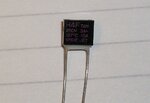- Joined
- Jul 4, 2009
- Messages
- 16,259
- Helped
- 5,140
- Reputation
- 10,309
- Reaction score
- 5,124
- Trophy points
- 1,393
- Location
- Aberdyfi, West Wales, UK
- Activity points
- 137,603
They should be OK then, usually when they go faulty they do so completely and it is very obvious.
If the fuse goes again I would be inclined to change it for a 2A or 2.5A one so it has a little more safety margin.
The charge probably continues even when the battery is full, provided it isn't done for too long it doesn't do any harm. If you have an LED to tell you the battery is charged up, it is almost certainly operated by a simple voltage monitor that senses when the pack has reached 12V or so.
Brian.
If the fuse goes again I would be inclined to change it for a 2A or 2.5A one so it has a little more safety margin.
The charge probably continues even when the battery is full, provided it isn't done for too long it doesn't do any harm. If you have an LED to tell you the battery is charged up, it is almost certainly operated by a simple voltage monitor that senses when the pack has reached 12V or so.
Brian.
